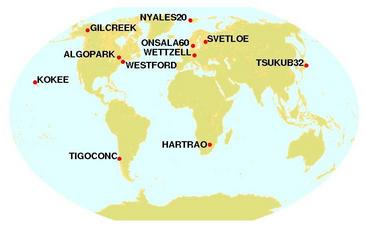
Click on image for larger version

HartRAO Home > news > Continuous Geodetic VLBI campaign CONT05 2005/09/12-27
This campaign is a successor to the successful CONT02 campaign, in which HartRAO was the only Southern hemisphere participant.

Preparations for the CONT05 campaign began months ago. This included extensive testing of hardware and development of new software.
The new high accuracy surface on the 26-m telescope and the consequential rebalancing of the structure with three tonnes of lead required the implementation of a new pointing model for the radio telescope to improve its pointing accuracy. This model is the one described by W E Himwich in the VLBI Field System Documentation. The work was carried out by Jonathan Quick, initially using the VLBI field system to make observations of bright, compact radio galaxies at 13cm wavelength, and then refined using the dual-beam Dicke-switched system at 3.5cm wavelength. After weeks of testing and refinement, the new model was made operational on September 12 for CONT05.
Two water vapour radiometers (WVRs) were obtained for the campaign. One is on long term loan from Fundamentalstation Wettzell operated by the Federal Agency for Cartography and Geodesy (Bundesamt für Kartographie und Geodäsie, BKG) in Germany. The second is on six months loan from the Geodesy and Geodynamics Lab of the Swiss Federal Institute of Technology in Switzerland. The WVRs improve accuracy through their direct measurement of the water vapour content of the atmosphere, which affects the transmission of the radio signals through it and thus affects the VLBI and associated GPS measurements.
In the following photo-essay, it is the morning of Tuesday 13 September. Pieter Stronkhorst has kept watch on the VLBI overnight and the day shift has arrived.
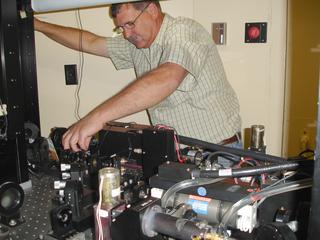
Johan Bernhardt checks the operation of the laser in the Satellite Laser Ranger.
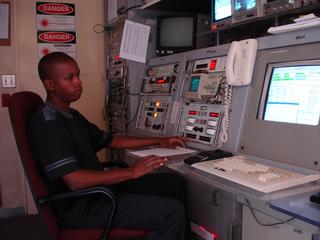
Inside the SLR, operator Sam Tshefu waits for the next satellite to rise: Starlette (SAC6179) is due to be tracked from 07h37 UT.

The laser's telescope slews around towards the predicted position of the satellite.
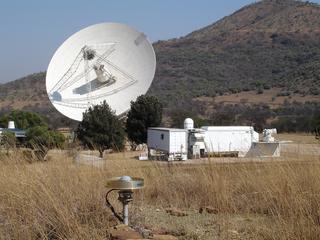
The radio telescope is observing the distant radio galaxy 1424-418 while the SLR points at the rise position for Starlette. In the foreground, the Global Positioning System base station antenna monitors is position continuously using the signals from the orbiting constellation of GPS satellites.

At the VLBI console in the radio telescope control room, Marisa Nickola checks the source schedule. Behind her on the right are the Mk IVB / V VLBI terminal. For CONT05 all our data are recorded to disk packs using the Mk V terminal. This morning each radio source is being observed for just one minute - more time is spent slewing from source to source than actually recording data, but it is essential to switch between sources widely spaced across the sky in order to maximise the accuracy of the positions determined for each radio telescope and thus for Earth orientation and rotation rate.
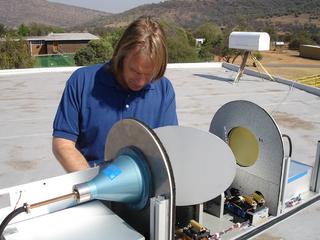
One water vapour radiometer is not behaving. Ludwig Combrinck looks for the problem. In the background, the second WVR is functioning correctly. They are located on the roof of the main observatory building.
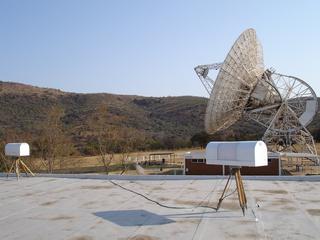
It is Thursday morning and both water vapour radiometers are working, the broken wire in a power supplying having been repaired in the one WVR.
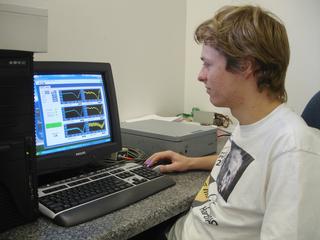
It is Friday morning, and geodesy student Gert Agenbag, who on Wednesday found the broken wire in the one water vapour radiometer, checks the on screen display of the data coming in from one radiometer.
The VLBI statistics for HartRAO are shown in this table.
The Satellite Laser Ranger operated with good weather for most of the experiment. The number of satellite tracks and returns recorded are shown in this table.
Towards the end of the two weeks, SLR was asked to give GFO-1, Envisat, Jason and TOPEX (altimeter satellites) tracking priority in view of Hurricane Rita's landfall near New Orleans.